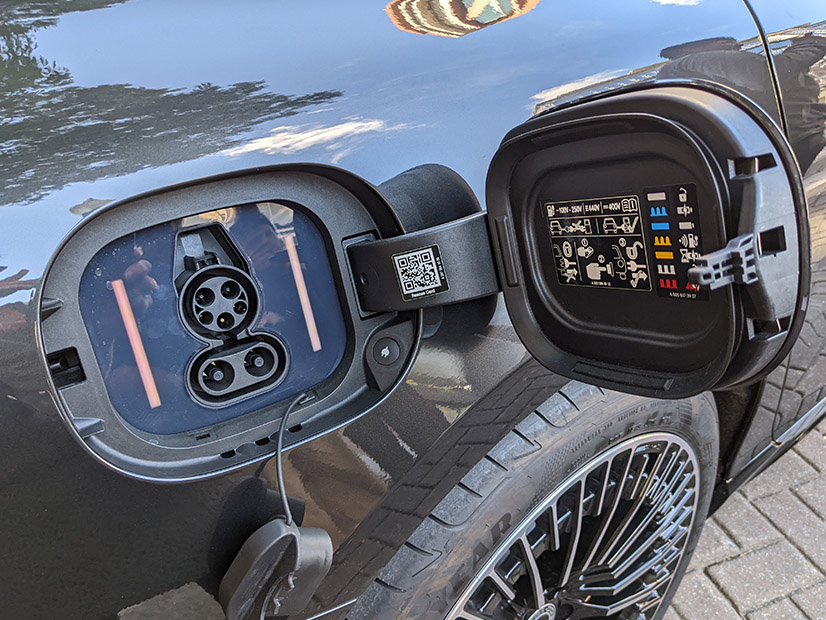
WASHINGTON — Electric vehicle stakeholders have largely praised the Biden administration’s standards for a national network of EV fast chargers that Transportation Secretary Pete Buttigieg promises would make “finding a charge as easy as filling up at a gas station.”
But high demand charges, limited electric distribution capacity and a lack of charging sites in rural areas raise barriers to EV adoption that standards alone may not be able to address, some say. Others question how the standards will be enforced.
The standards proposed by the Federal Highway Administration June 9 would cover EV chargers funded through $5 billion in state grants from the Infrastructure Investment and Jobs Act (IIJA). The administration wants to install 500,000 chargers, with sites every 50 miles on U.S. highways. They would be 150-kW DC fast chargers that can power up any EV make or model, are publicly available 24-7, accept any debit or credit card, and are operating 97% of the time. (See Biden Administration to Order EV Charging Standards.)
Mike Calise, president of the Americas for Australia-based Tritium Charging, which is opening a new plant in Tennessee later this year, said standards are critical “because everyone has to be working to the standards in order for this widespread [EV] adoption to occur.
“It doesn’t matter whether they are perfect, what matters is that they’re adoptable by the masses,” he said.
Rural Challenges
Meeting the 50-mile goal could be a challenge for electric cooperatives, said Brian Sloboda, consumer solutions director at the National Rural Electric Cooperative Association (NRECA).
Co-ops often serve remote and rural areas with “major stretches of highway that actually don’t have suitable site hosts — no restaurants, no gas stations,” Sloboda said. “You can go more than 50 miles in parts of the country and not see anything along these highways.”
Joel Levin, executive director of Plug In America, a nonprofit focused on consumer issues, said fast chargers in remote areas could rack up high utility demand charges, creating yet another barrier.
Based on peak usage, demand charges for DC fast chargers “can be really significant,” Levin said. “Let’s say you’ve got four chargers and four people pull in, use them [simultaneously], and then no one uses them again for a week. Your demand charges are going to be really high, and you’re going to have practically no revenue to support it.”
Gas vs. Charging
For Anthony Castro, a sales consultant at Euro Motorcars, a Mercedes Benz dealership in Bethesda, Md., even fast chargers required by the standards may not close the gap between the time it takes to pump gas and the time it takes to charge an EV.
With a 200-kW fast charger, Mercedes’ new luxury EV, the EQS, can go from being 10% to 80% charged in 30 minutes, Castro said.
“So, a 150 [-kW charger] will take a little bit longer,” he said. “Maybe like 35 minutes.”
Tritium’s Calise believes the comparison between gas stations and EV charging stations needs to be reframed. For some consumers, fast charging stations will offer a “convenience lifestyle,” he said.
Tritium’s fast chargers can provide 100 miles of added range in about 10 minutes, Calise said. “The benefit is you’re in your car versus outside pumping. You sit back, relax in air conditioning and text your kids.”
Castro and Calise were among the electric automakers and EV charging providers showing off their wares at the Department of Transportation headquarters as part of the rollout of the new standards. U.S. sales of all-electric and plug-in hybrids grew from 308,000 in 2020 to 608,000 in 2021, according to figures from the Department of Energy.
The range of vehicles on display at the DOT reflected this growth and the expansion of consumer choices, from the high-end EQS (350-mile range, $102,310 sticker price) to the wallet-friendly Chevrolet Bolt (259-mile range; 2023 sticker price $26,595).
The fast chargers on display were not all compliant with the proposed standards — company executives said they had to bring smaller models for ease of shipping — but most said they had 150-kW models and expected they would be able to meet the administration’s benchmarks for convenience and reliability.
Reliability Complaints
But consumer advocates remain skeptical.
Carleen Cullen, executive director of nonprofit Cool the Earth, says the 97% reliability requirement, which includes extensive data collection and quarterly reports, has no teeth.
“There are no enforcement mechanisms, no penalties for failure and no third-party testing of charging reliability,” she said. “We simply will not achieve the essential transition to EVs without enforcement, penalties and verification of uptime reliability at publicly funded EV charging.”
Recent studies from Plug In America and Cool the Earth suggest that companies’ reliability claims are not always matched by consumers’ experiences. Plug In America’s survey of more than 5,500 EV owners found that broken or otherwise nonfunctioning chargers were a top complaint.
“The public charging network is kind of frustrating,” Levin said. “It’s a patchwork of different networks. Some of them take credit cards; a lot of them don’t. Some of them tell you how much you are paying up front; a lot of them don’t. … If you drive a gas car, you never have that experience.”
He believes the standards’ requirement that each federally funded public charging station have at least four ports could provide a higher level of reliability. Even if one charger is down, others may be available, he said.
Cool the Earth tested several hundred public fast chargers in California — in some cases, visiting twice — and found that almost 23% were not functional.
“The findings suggest a need for shared, precise definitions of and calculations for reliability, uptime, downtime and excluded time, as applied to open public [DC fast chargers], with verification by third-party evaluation,” the group’s report said.
Phil Jones, executive director of the Alliance for Transportation Electrification (ATE), said the standards may be setting the reliability bar too low. While “97% sounds high, it’s really not that high” Jones said. “When you think of a consumer, an EV owner who goes to [a fast-charging] station, they expect it to be on all the time. Having two hours a month or five hours a month for a certain charger to be out of service, some people would say is not acceptable.”
Demand Charges
ATE raised a second concern in a recent report arguing that high demand charges could “stymie the deployment of the new commercial fast charging stations.
“Since EVs come with many benefits to utilities, their customers and society at large, and because public policy considerations are part and parcel of the rate design process, the Alliance supports demand charge relief as the market develops,” the report says.
The issues are complex, Jones said, and utilities across the country are experimenting with different approaches to demand charge mitigation. Examples include traditional commercial rates with a short-term waiver of demand charges to offset low utilization rates in remote areas or nascent markets. Under subscription rates, by contrast, low or growing demand can be incorporated into a monthly charge included in the rate base.
As more EVs are on the road, and public charging stations see more vehicles, the report sees a cross-over point where mitigation measures could be more expensive than demand charges, the report says.
With waivers, Jones said, “It’s basically saying for six years, eight years, 10 years, the demand charge is going to be mitigated way down to either zero or 10%. And then when utilization of the charging station picks up, probably the demand charge is better … and kicks back in.”
Interconnection
Interconnecting fast chargers on utility distribution systems is yet another challenge, especially in locations where fast chargers add demand to already congested lines.
EV charging stations could run into the delays that have plagued commercial and community solar in some regions as individual feeders may not have the capacity required for four or more 150-kW chargers, Jones said. Further, the hosting capacity maps some utilities offer to help developers site their projects may be out of date or inadequate, he said.
“They’ll get a certain answer there, but when they actually go and talk to the [utility] program managers and the distribution engineers, it’s different. So, we have a lot of work to do there,” he said.
“We don’t have the distribution network to support these ultrafast charging loads on retail sites where you and I need to go to charge our vehicle,” said Arcady Sosinov, CEO of charging provider FreeWire Technologies, which has developed a fast charger with a built-in battery pack. “We’re not looking to charge next to utility substations; we’re looking to charge at Starbucks, at Whole Foods, at the quick-service restaurants. And these sites simply don’t have the power available today.
“You’re looking at total utility infrastructure buildout,” Sosinov said. “That means bringing new power to these sites, new transformers, new switchgears, new substations. That’s where the problem lies.”
Sosinov says fast chargers with built-in batteries, like FreeWire’s models, can address both interconnection challenges and demand charges. The battery can smooth out the spikes caused by fast charging, which in turn drive both interconnection and demand charge issues.
NRECA and the Edison Electric Institute (EEI) acknowledge that not all distribution lines are ready for the new load that DC fast chargers will bring. But they maintain that the way forward begins with good planning and communication with the state departments of transportation (DOTs) that are developing EV charging deployment plans governing how they will spend the IIJA funds.
Still another requirement is that charging stations be located no more than one mile off major highways or other key traffic corridors — another effort to replicate a gas station-like experience. If such locations do not have enough capacity, utilities can plan ahead to make the necessary system upgrades, Sloboda said. “The charger won’t be installed today. It’s going to take a while for that charger to show up, and what you do not want is to have that charger installed and not connected to the grid.”
“We would prefer states not submit a plan and say, ‘Okay now, electric companies, what can you do for me?’” said Kellen Schefter, EEI’s senior director of electric transportation. Early communication allows for “iterative conversations,” he said, so utilities can identify the locations where EV chargers can be deployed quickly and others where “a longer time horizon” is needed for system upgrades.
‘Different Vocabularies’
Both Sloboda and Schefter said planning for these fast-charging networks has opened new lines of communication between utilities and the state DOTs, which may lack expertise on utility distribution systems.
At the same time, energy officials may not know transport, said Jim McDonnell, director of engineering for the American Association of State Highway and Transportation Officials (AASHTO). His organization is planning sessions for state transportation and energy officials “to try to bridge the learning curve that needs to take place. The two industries have different vocabularies and different ways of doing things.”
He, Sloboda and Schefter all gave high marks to the Biden administration’s Joint Office of Energy and Transportation, set up earlier this year to help states develop their EV charging plans, which must be submitted by Aug. 1.
A 60-day comment period on the new standards will still be open at that time, but Susan Howard, AASHTO’s director of policy and government relations, said, such overlap is not uncommon.
“The state plans are really focused on where the charging is going to be, the requirements for the distance from the interstate, looking at the alternative fuel corridors,” she said. The standards are “really focused on the what.”
McDonnell said the Aug. 1 filings won’t be the last word. “The state plans are intended to be living documents that will be refined and updated and modified appropriately over the coming five-year period of the entire infrastructure bill,” he said. The standards “will come into play when they are actually putting RFPs out on the street for companies to help them build out their charging systems.”
